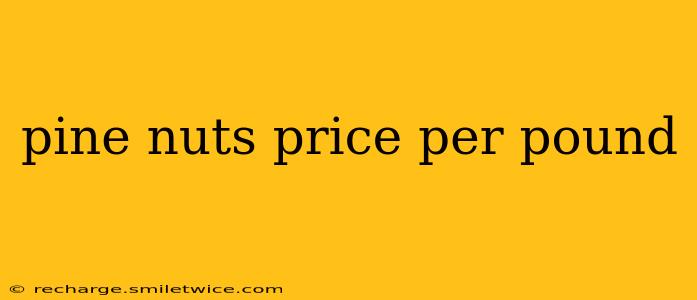Pine nuts, those deliciously crunchy and subtly sweet kernels, are a culinary treasure prized for their unique flavor and nutritional benefits. However, their price can fluctuate significantly depending on several factors. This guide will delve into the complexities of pine nut pricing, exploring the reasons behind the price variations and offering tips on how to find the best deals.
What Factors Influence Pine Nut Prices Per Pound?
The cost of pine nuts per pound isn't a fixed number. Several interconnected factors contribute to its volatility:
-
Harvest Yield: Like any agricultural product, the success of the pine nut harvest directly impacts supply. Poor weather conditions, pests, or diseases can drastically reduce yields, leading to higher prices. Conversely, a bountiful harvest can lower prices.
-
Type of Pine Nut: Different pine species produce nuts with varying qualities and sizes. Some varieties, like the prized Italian stone pine (pinoli), command higher prices due to their superior flavor and smaller size, resulting in more nuts per pound. Others, like the more readily available Chinese pine nuts, are generally less expensive.
-
Processing and Packaging: The methods used to harvest, clean, shell, and package pine nuts also influence the final cost. Hand-processed nuts are typically more expensive than machine-processed ones. Similarly, packaging in smaller, more attractive containers often increases the price.
-
Geographic Location: The location of both production and sale plays a role. Pine nuts imported from faraway locations might incur higher transportation costs, reflecting in the price per pound. Local or regional sourcing may be more affordable.
-
Retailer Markups: The retailer's profit margin also contributes to the final price. Specialty food stores or gourmet markets typically charge more than supermarkets or online bulk retailers.
-
Supply Chain Disruptions: Global events such as pandemics, trade wars, or natural disasters can disrupt the supply chain, causing fluctuations in pine nut availability and price.
How Much Do Pine Nuts Cost Per Pound?
Providing an exact price per pound is challenging due to the aforementioned variability. However, as a general guideline, you can expect to pay anywhere from $15 to $50 or more per pound. The lower end of this range typically reflects bulk purchases of less expensive varieties, while the higher end represents premium, small-batch, or specialty pine nuts.
Where Can I Find the Best Deals on Pine Nuts?
Finding affordable pine nuts requires a little research and awareness. Consider these options:
-
Bulk Retailers: Online retailers and warehouse clubs often offer competitive prices for bulk purchases. Be sure to compare prices and shipping costs before ordering.
-
Ethnic Grocery Stores: These stores sometimes carry pine nuts at lower prices than mainstream supermarkets.
-
Local Farmers' Markets: If available in your area, consider checking local farmers' markets for freshly harvested, locally sourced pine nuts.
-
Seasonal Sales: Keep an eye out for seasonal sales or discounts, particularly around harvest time.
What Are Some Pine Nut Alternatives?
If the price of pine nuts is a concern, several alternatives offer a similar crunch and texture:
-
Sunflower Seeds: A readily available and budget-friendly option.
-
Pumpkin Seeds: Another affordable and nutritious substitute.
-
Walnuts: Provide a heartier texture and flavor.
How to Store Pine Nuts to Maintain Freshness
Pine nuts, especially once shelled, are susceptible to rancidity. Proper storage is crucial to maintain their quality and delicious flavor. Store them in an airtight container in a cool, dark, and dry place. Refrigeration or freezing can further extend their shelf life.
By understanding the factors influencing pine nut prices and exploring different purchasing options, you can enjoy this delicious ingredient without breaking the bank. Remember to always check current prices and compare options before making your purchase.
